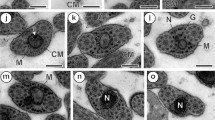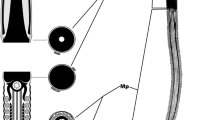Summary
Sperm ultrastructure and spermiogenesis of the enteropneust hemichordate Saxipendium coronatum conforms to the general pattern of the prototype spermatozoon found in many phyla. The sperm is about 29 μm long, including head, middle piece, and tail. The Saxipendium spermatozoon has some unique features. The head is pyramidal in shape and the nucleus has four frontal ridges radiating from the base of the acrosomal region. The acrosome is composed of a large acrosomal vesicle surrounded by periacrosomal material. The acrosomal region projects about 1 μm in front of the nucleus and has a width at the base of 1.5 μm. The middle piece is dish-shaped and contains a large mitochondrial mass surrounding the centriolar region. The centriolar region is partially located in a centriolar fossa at the basal part of the nucleus. In spermatids, an anchoring fiber apparatus is observed surrounding the centriolar region. The distal ends of the fibers are attached to the plasmalemma by electron-dense thickenings. The tail is a simple flagellum. The sperm of Saxipendium and the small eggs found in the female suggest non-specialized external fertilization and embryogeny leading to a planktotrophic larva. The main results of the fine structure of the spermatozoon in Saxipendium are summarized in Fig. 12.
Similar content being viewed by others
Abbreviations
- an :
-
antrum
- av :
-
acrosomal vesicle
- ax :
-
axoneme
- d :
-
distal centriole
- ep :
-
epidermis
- f :
-
flagellum
- gp :
-
gonopore
- m :
-
mitochondrion
- mp :
-
middle piece
- n :
-
nucleus
- p :
-
proximal centriole
- per :
-
periacrosomal material
- sp :
-
sperm
- te :
-
testis
- vac :
-
vacuolated cells
References
Afzelius BA (1979) Sperm structure in relation to phylogeny in lower Metazoa. In: Fawcett DW, Bedford JM (eds) The spermatozoon, 243–251, Urban & Schwarzenberg, Baltimore-Munich
Afzelius BA, Franzén Å (1971) The spermatozoon of the jellyfish Nausithoe. J Ultrastruct Res 37:186–189
Burke RD (1983) The induction of metamorphosis of marine invertebrate larvae: stimulus and response. Can J Zool 61:1701–1719
Chia FS, Bickell LR (1983) Echinodermata. In: Adiyodi KG, Adiyodi RG (eds) Reproductive biology of Invertebrates, Vol II Spermatogenesis and sperm function, John Wiley & Sons Ltd, Chichester New York, pp 545–620
Chia FS, Atwood D, Crawford B (1975) Comparative morphology of echinoderm sperm and possible phylogenetic implications. Am Zool 15:533–565
Colwin AL, Colwin LH (1963) Role of the gamete membranes in fertilization in Saccoglossus kowalevskii (Enteropneusta). J Cell Biol 19:477–500
Franzén Å (1956) On spermiogenesis, morphology of the spermatozoon, and biology of fertilization among invertebrates. Zool Bidr Upps 31:355–482
Hadfield MG (1977) Growth and metamorphosis of planktonic larvae of Ptychodera flava (Hemichordata: Enteropneusta) In: Fu-Shiang Chia, Rice ME (eds) Settlement and Metamorphosis of Marine Invertebrate Larvae, pp 247–254
Hyman LH (1959) Hemichordata in “The Invertebrates: Smaller Coelomate Groups” 5:72–207
Jablonski D, Lutz RA (1983) Larval ecology of marine benthic Invertebrates: paleobiological implications. Biol Rev 58:21–89
Lutz RA, Jablonski D, Turner RD (1984) Larval development and dispersal at Deep-sea hydrothermal vents. Science 226:1451–1453
Pechenik JA (1980) Growth and energy balance during the larval lives of three prosobranch gastropods. J Exp Mar Biol Ecol 44:1–28
Retzius G (1906) Die Spermien der Enteropneusten und der Nemertinen. Biol Unters (NF) 13:37–40
Turner RD, Lutz RA (1984) Growth and distribution of mollusks at deep-sea vents and seeps. Oceanus 27:54–62
Wirth U (1984) Die Struktur der Metazoen-Spermien und ihre Bedeutung für die Phylogenetik. Verh Naturw Ver Hamburg (NF) 27:295–362
Woodwick KH, Sensenbaugh T (1985) Saxipendium coronatum, new genus, new species (Hemichordata:Enteropneusta): the unusual spaghetti worms of the Galápagos Rift hydrothermal vents. Proc Biol Soc Wash 98:351–365
Author information
Authors and Affiliations
Rights and permissions
About this article
Cite this article
Franzén, Å., Woodwick, K.H. & Sensenbaugh, T. Spermiogenesis and ultrastructure of spermatozoa in Saxipendium coronatum (Hemichordata, Enteropneusta), with consideration of their relation to reproduction and dispersal. Zoomorphology 105, 302–307 (1985). https://doi.org/10.1007/BF00312061
Received:
Issue Date:
DOI: https://doi.org/10.1007/BF00312061




